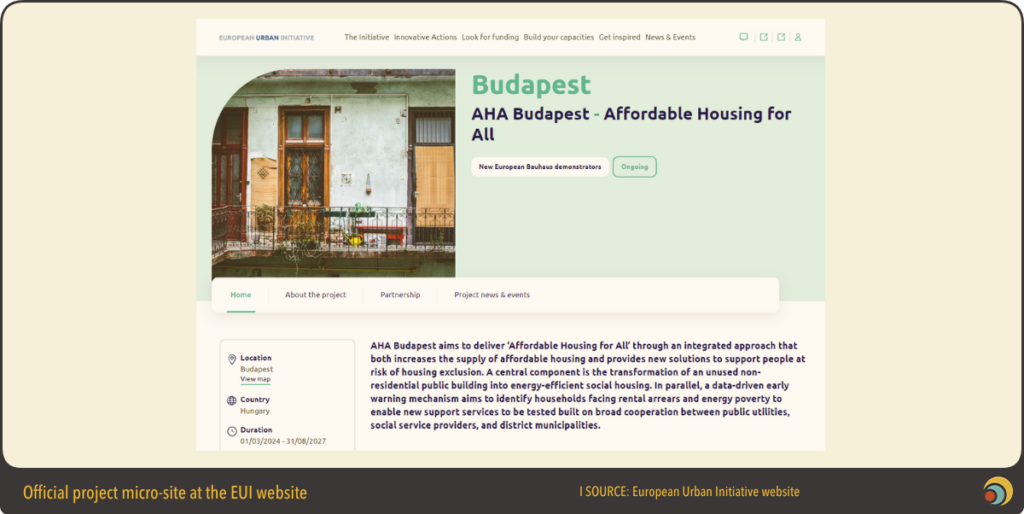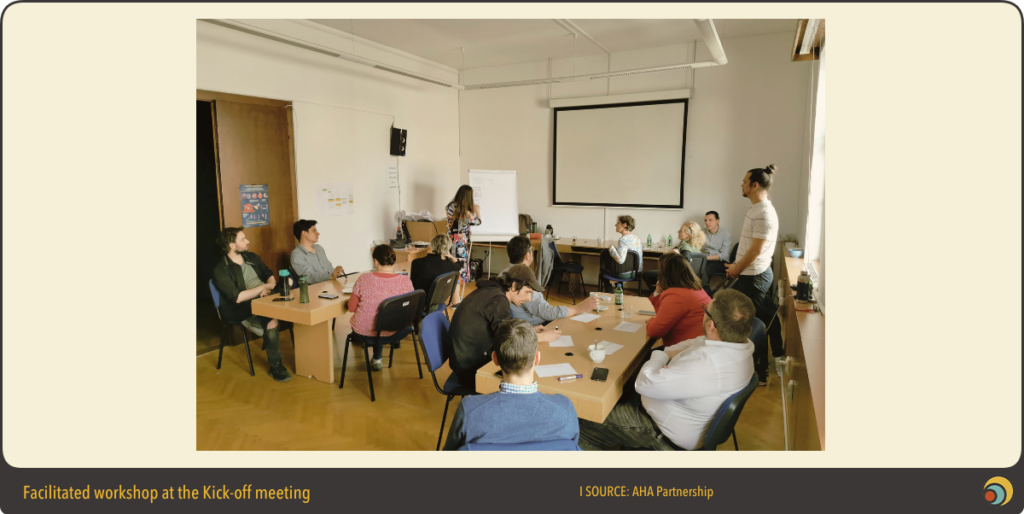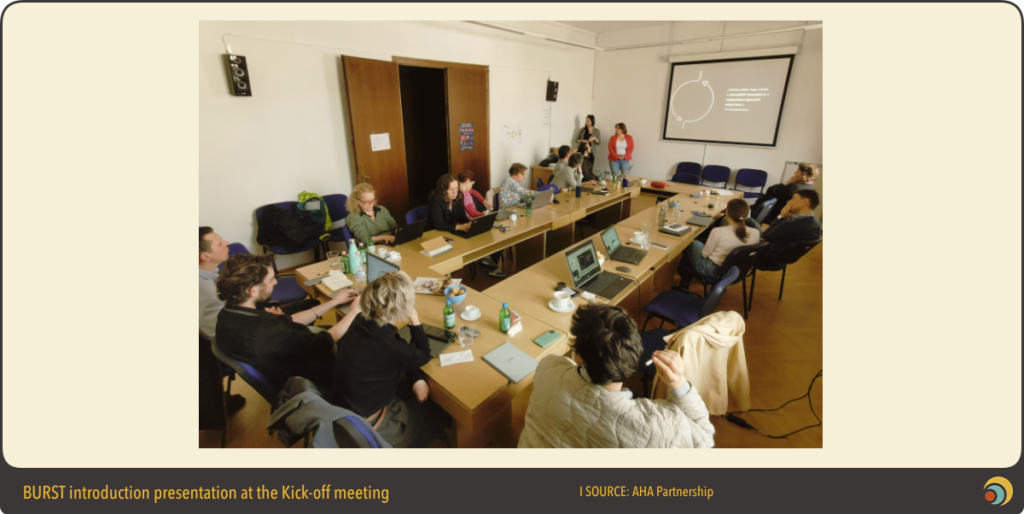The cost of housing is increasingly becoming a significant issue in all major European cities. Budapest, where BURST is based, however, is especially hard hit by the housing crisis, seeing one of the largest increases in housing prices in Europe. Meanwhile, as the yearly housing report of Habitat for Humanity Hungary highlights, there are no centralised initiatives in Hungary to make housing more affordable, for example, by supporting municipalities in building new homes. This also means that municipalities are often alone in trying to mitigate the housing crisis, while housing is increasingly unaffordable for many. As Petra Madaras-Horogh, a project manager at BURST explains, fewer and fewer people can afford suitable, quality homes. This, according to Petra, increases the pool targeted by municipal social housing. Therefore, access to social housing needs to be widened.
AHA, a new European Urban Initiative Innovative Action project, led by the Municipality of Budapest, is attempting to counter this trend. We, as BURST, are proudly part of this truly initiative. We are responsible for coordination between partners, exploring sustainability and scaling-up, for transferring the project to other European areas.

Budapest’s new housing agency
One of the major issues in Budapest is that (according to the 2022 census) 150 thousand flats are uninhabited. This is one of the reasons why, despite the slow decrease in population, Budapest has seen skyrocketing housing costs. Some of these flats are in use, for example as offices or, more controversially, as short-term holiday lets, but it is likely that many thousands of housing units are empty because the owners do not have the capacity to manage these flats or are not willing to take the risk of finding suitable tenants.
The social housing agency model is offered as a potential solution. It creates a new mode of managing the municipal housing stock, but also allows private owners to offer their real estate to the municipality for social housing. While this would mean lower rents for the owner, it also means that the municipality is responsible for the flat. For example, it is now the risk of the municipal agency to find suitable tenants, and the municipality would ensure that repairs are made, subsidising them for the tenants as necessary. It is hoped that this de-risked opportunity to lend out flats will make some of those empty flats habited once more. However, as Petra emphasises, this needs flexibility also from the housing agency in how they run their affairs.
The housing agency model will be pioneered on a city-wide scale (there are some district-level housing agencies already). This work will be led by From Street to Homes! Association, a leading Hungarian advocate for sustainable housing, who first introduced the housing agency model in Hungary. As Petra explains, the specifics of the housing agency model still need to be hammered out, and one of the key aspects of this project will be to figure out how housing agencies can be run, for example, without becoming over-bureaucratised.
Of course, for the model to be truly successful, significant change is needed in attitudes towards housing. Hence AHA will encompass multiple community-oriented actions. Tenant participation will be fostered in maintenance, while the project will also raise awareness about the positive aspects of new models of housing among Budapest residents.

Turning an empty building into sustainable housing
Another key aspect of this project, as Petra explains, is hard investment in a sustainable social housing apartment building. The Municipality of Budapest will renovate a building, formerly not used for housing, in order to boost the social housing sector with additional flats. They will also test in this – relatively – small scale investment some architectural solutions that can be later scaled up, as Petra explains. (‘Small’ is the wrong word here, of course: the investment will amount to almost €2 million.)
This is how AHA relates to the New European Bauhaus initiative. Through the work of NART Architects, an architectural firm involved in the project, an interior design guideline – a so-called ‘NEB Cookbook – that will help tenants maintain their flat and can be used by other parties throughout the world.
Beyond design principles, social innovations, such as placemaking (led by Hungarian Contemporary Architecture Centre) and the use of volunteering in construction. This latter will be led by From Streets to Homes! Association, who already pioneered the use of volunteer labour in albeit smaller renovation projects. Indeed, this is their core mission: offering to renovate inhabitable council flats through volunteering and donated contributions. This model, too, will be tested on a larger scale here.
The newly repurposed building will also have two community facilities, which will serve tenants living in the building and also a street-facing area that will serve the wider community. These spaces will be co-designed, so the functions of the common areas (which may vary from a communal garden to washing facilities) will serve them best.
Using digital tools to support housing
As Petra explains, a major part of the project will focus on developing new IT tools. Some of them will support the housing agency, but an important innovative aspect will be the development of an early warning system, detecting households at risk of, for example, eviction. Led by the Metropolitan Research Institute, an Early Warning System methodology will be designed, that will support the municipality in identifying at-risk individuals.
These services will focus on social support, but also on energy-related problems. After 2022, energy costs have skyrocketed in Hungary, which created a further axis in housing-related risks. The project will therefore elevate energy interventions into its support services – and enlisted the Hungarian Energy Efficiency Institute Non-profit Public benefit Ltd. to help with these issues. Some other innovative services will be the management of flexible housing solutions – such as subletting – through the municipal Early Intervention Office.
Another key issue in Budapest is that social housing is managed both by the Municipality of Budapest and by various district municipalities. However, for most people seeking social housing, this creates a difficult situation, where they have to navigate two or more systems. The AHA digital platform will be designed to allow this problem to be overcome – hopefully.
The whole partnership participated in the project Kick-off meeting which took place at the Municipality of Budapest, on 21-22 March 2024.

How will the AHA model spread?
The main aim of the European Urban Initiative – similar to the previous Urban Innovative Actions programme – is to ensure that novel solutions are tested in European cities that will foster the transformation of urban areas throughout the EU. This is crucial as projects such as AHA not only deliver for local residents but also create innovative solutions on a bigger level that tackle our shared problems. To reap the benefits of these projects, thus, they should also explore how their solutions will be transformed.
Therefore, as an EUI Innovative Actions project, AHA involves three transfer cities – Pula in Croatia, Breda in the Netherlands, and Municipality of Alfafar in Spain – in the main project already. This will ensure that the positive results of the project are transferred to these local contexts, and thus the good practices explored in AHA will serve those in need of housing throughout Europe.
AHA, in the short term, should help Budapest end its housing crisis. In the long run, it also should be a major step to solving Europe’s.

Petra graduated as an architect at the Budapest University of Technology and Economics and has a degree in Urban Planning and Design. She has been working in urban design and development since 2013. After the public sector she joined the private sector and became a senior consultant and project manager of transnational urban development EU funded projects. She is proficient in facilitating cross-cultural collaboration, organizing and conducting international partner meetings and leading community building.
She is a housing expert – especially community-led housing- and on behalf of BURST she is the thematic expert of the AHA project.
She is one of the founding members and co-president of the CoHousing Budapest Association. She has done theoretical and empirical research in the field of community-led housing over the past 12 years. She believes that community building is essential for cooperation, not only in housing but also in day-to-day work, as cooperation is the key to a better future.
